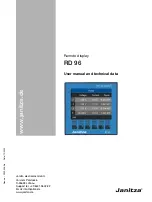
st
eut
e T
echnol
ogies GmbH & Co. K
G
Brück
ens
tr
aße 91, 32584 Löhne, Germany
, www
.s
teut
e.c
om
//
RF HB-4CH SW868/SW915/SW917/SW922-NET
2 / 16
Montage- und Anschlussanleitung / Funkschalter
Mounting and wiring instructions / Wireless switch
Instructions de montage et de câblage / Interrupteur sans fil
Istruzioni di montaggio e collegamento / Interruttore wireless
Instruções de montagem e instalação / Interruptor de rádio frequência
Инструкция по монтажу и подключению / Радио-выключатель
English
Destination and use
The device of type SW868 is intended for use(in the European Union.
It complies with the European Union’s Directive 2014/53/EU (RED) for
radio equipment.
The device of type SW915 is intended for use in Canada, USA, and
Mexico. It complies with the requirements of FCC Rules and IC Rules,
RSS-210. It has an approval number for the Mexican states.
The device of type SW917 is intended for use in Brazil. It complies with
the requirements of Resolucão 242/2000.
The device of type SW922 is intended for use in Japan. It complies with
the requirements of ARIB STD-T108.
The four channel wireless switch is used to switch electrical loads via
radio transmission. The transmission is carried out at a frequency of
868.3 MHz (EU) or 915.0 MHz (USA, Canada, Mexico) or 917.0 MHz
(Brazil) or 916.5 MHz (Japan). The receiver must conform to the
sWave.NET® protocol of the steute modules.
Mounting / Wiring
The wireless switch must be installed according to the mounting
and wiring instructions of the receiver. The wireless range accord-
ingly depends on the local conditions. Thus, the radio signal can be
strongly affected by conductive materials. This also includes thin
foils, e.g. aluminium laminations on insulation materials.
Design of wireless range
Because radio signals are electromagnetic waves, the signal is attenu-
ated on its way from the transmitter to the receiver. This means the
electrical as well as the magnetic field strengths decrease inversely
proportionally to the squared distance of transmitter and receiver
(E,H~1/r²). In addition to this natural restriction of the wireless range,
further interference factors occur: metal parts, e.g. armours in walls,
metal foils of thermal insulations or vapour deposited metal layer heat
protection glass, reflect electromagnetic waves. Therefore, a so-called
deadspot can be found behind them. Radio waves are able to penetrate
walls but the attenuation increases even more than in the free field.
Penetration of radio waves:
wood, gypsum, glas uncoated
90...100%
brick stone, press boards
65...95%
armoured concrete
10...90%
metal, aluminium lamination, water
0...10%
Typical wireless ranges are:
Sight connection in free field:
approx. 450 m
Sight connection indoors:
approx. 40 m
Sight connection in free field (SW922):
approx. 150 m
Sight connection indoors (SW922):
approx. 20 m
Safety
The wireless switch must not be used in connection with other devices
whose direct or indirect purpose is to ensure life or health, or whose
operation may pose a threat to humans, animals or material assets.
The described products were developed in order to assume safety
functions as part of an entire plant or machine. The responsibility
taken by the manufacturer of a plant or machine implies to secure
the correct general function.
Notices
To avoid too fast actuation, there is, by default, a delay time of 1 s when
processing one switching command from transmitter to receiver (if the
radio interface is unoccupied and there are no repeat telegrams).
The switching signal of a transmitter must not be generated in shorter
time sequences otherwise this signal will be suppressed. The preset
delay time of 1 s can be adjusted from min. 125 ms to max. 31.9 s (see
RF RxT SW868/915/917/922-NET, »Description of interface/Wireless
receiver«, section »StateMessage-Response«, paragraph »RECORD.
CYCLETIME«, download from www.steute.co.uk). Subject to technical
modifications. Reconstruction and alterations at the device are not
allowed. Moreover, steute does not assume any liability for recommen-
dations made or implied by this description. From this description new
claims for guarantee, warranty or liability cannot be derived beyond
the general terms and conditions of delivery.
Maintenance / Cleaning
We recommend regular maintenance as follows:
1. Check actuator for easy operation.
2. Remove all dirt or particles.
Clean enclosure on the outside only. Clean enclosure with household
cleaning agents. Do not use compressed air to clean.
Battery
The battery charge is displayed in the description of interface in sec-
tion »RECORD.BATT« as mV (see RF RxT SW868/915/917/922-NET,
»Description of interface/Wireless receiver«, chapter »DataMessage«.
Download the »Description of interface« from www.steute.co.uk). If the
description of interface shows the battery charge drop under approx.
<2200 mV (at 20°C, approx. 20 mA load), the battery may be empty.
Caution: Measuring the off-load voltage does not provide any reliable
data!
To ensure a safe function, replace the battery. To do this, open
the enclosure by removing the cover screw using a cross screwdriver.
Check that polarity matches the symbols inside the enclosure. Use
only the designated or a complementary battery type.
Disposal
- Observe national, local and legal regulations concerning disposal.
- Recycle each material separately. Dispose of possibly contained
batteries correctly.
ESD
In case of operations which require an open device, ensure an ad-
equate ESD protection.
ESD
Bei allen Arbeiten, die das Öffnen des Gerätes erforderlich machen,
auf ausreichenden ESD-Schutz achten.
Deutsch (Originalbetriebsanleitung)


































